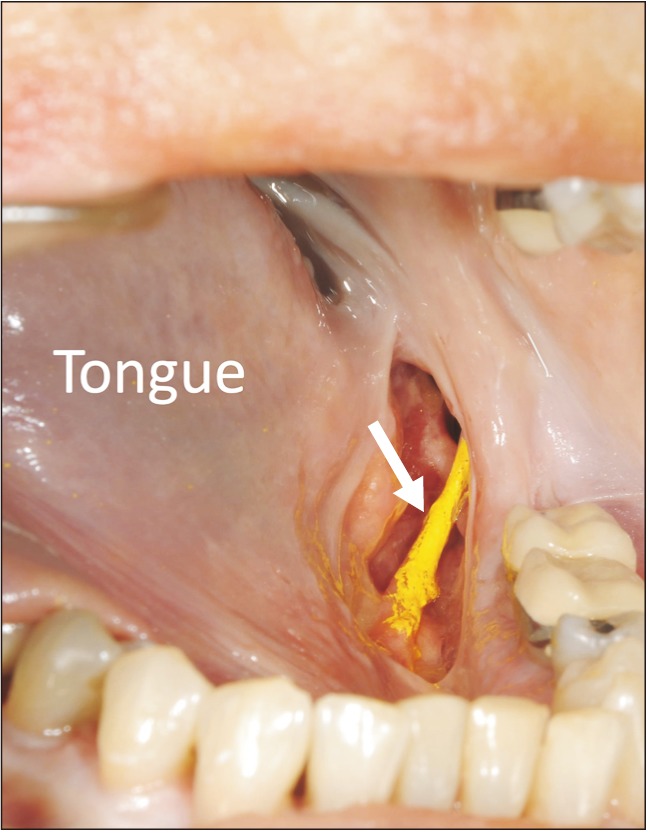The LN arises from the posterior division of the mandibular nerve under the foramen oval and into the infratemporal fossa [
12]. It then travels under the mandibular attachment of the superior pharyngeal constrictor and pterygomandibular raphe and approaches the lower third molar. Kiesselbach and Chamberlain [
5], in a study of 34 adult cadaveric heads, described that the LN contacted the lingual plate in 62% and existed at or above the alveolar crest in 17.6% at the region of the third lower molar. Miloro et al. [
13], using high-resolution magnetic resonance imaging (HR-MRI), reported that the LN contacted the lingual plate in 25% and existed at or above the alveolar crest in 10% of patients at the region of the third lower molar. Behnia et al. [
4], in 430 fresh cadaveric heads, also reported that the LN contacted the lingual plate in 22.3% of patients and existed above and below the lingual crest in 14.5% and 85.8% at the region of the third lower molar, respectively. There are several pieces of literature that described the diameter of the LN at the third lower molar [
571314]. Kiesselbach and Chamberlain [
5] showed that the diameter of the nerve was 1.86 mm in 34 adult cadaveric heads. Miloro et al. [
13] studied using HR-MRI that the diameter was 2.54 mm (range, 1.58–3.13 mm) in 10 volunteers (mean age, 24.7 years; range, 21–35 mm). Hölzle and Wolff [
14] reported that the diameter was 2.7±0.3 mm (range, 1.9–3.6) in 68 specimens (34 formalin-fixed cadaveric heads). Kim et al. [
7] also clarified that the diameter was 3.3±0.6 mm (range, 2.2–4.4) in 32 specimens (hemi-sectioned formalin-fixed cadaveric heads). In our study, the diameter of the LN in the fresh frozen cadavers was 2.20±0.37 mm (range, 1.61–2.95). However, several authors reported that the mean diameter of the LN at the retromolar area was 3.62±1.0 mm (range, 2.5–4.5) [
6], 2.3±0.4 mm (range, 1.5–3.5) [
7], and 2.04±0.4 mm (range, 1.42–2.96) [
8] in formalin-fixed cadavers. At the horizontal plane of needle placement, the mean diameter of the LN in formalin-fixed cadavers was 3.42±0.38 mm (range, 2.55–4.15) [
15]. At the pterygomandibular space, the mean diameter of the LN was 2.57±0.44 mm in fresh frozen cadavers and 2.97±0.48 mm in formalin fixed cadavers [
16]. There is a discrepancy in the mean diameter of the LN in the literature (
Table 1). However, Hölzle and Wolff [
14] concluded that the influence of formalin fixation on the shape of the LN was minimal by comparing its shape between formalin fixed and fresh cadavers. By contrast, Iwanaga et al. [
16] reported that the mean diameter of the LN had a statistically significant difference between fresh-frozen and formalin-fixed cadavers. Despite some discrepancy between these studies, there is no doubt that the LN is a risk factor during oral surgery.
Table 1
The diameter of the lingual nerve in each measurement site

|
Study |
Year |
Subject |
No. of sides |
Mean diameter (mm) |
Measurement site |
|
Kiesselbach and Chamberlain [5] |
1984 |
Cadaver (no detail) |
34 |
1.86 |
Lower third molar |
|
Pogrel et al. [6] |
1995 |
Cadaver (no detail) |
40 |
3.62 |
Retromolar |
|
Miloro et al. [13] |
1997 |
Volunteers (HR-MRI) |
20 |
2.54 |
Lower third molar |
|
Hölzle and Wolff [14] |
2001 |
Formalin-fixed cadaver |
68 |
2.7 |
Lower third molar |
|
Kim et al. [7] |
2004 |
Formalin-fixed cadaver |
32 |
3.3 |
Lower third molar |
|
2.3 |
Retromolar |
|
Erdogmus et al. [8] |
2008 |
Formalin-fixed cadaver |
42 |
2.04 |
Retromolar |
|
Morris et al. [15] |
2010 |
Formalin-fixed cadaver |
44 |
3.42 |
Horizontal plane of needle placement (inferior alveolar nerve block) |
|
Iwanaga et al. [16] |
2018 |
Fresh-frozen cadaver |
32 |
2.57 |
Pterygomandibular space |
|
Formalin-fixed cadaver |
12 |
2.97 |
|
Present study |
2018 |
Fresh-frozen cadaver |
20 |
2.20 |
Lower third molar |

In conclusion, this study observed the detailed diameter of the LN using fresh frozen cadavers. A better anatomical understanding of the LN may help minimize LN injury, which is a severe complication of oral procedures.





 PDF
PDF ePub
ePub Citation
Citation Print
Print



 XML Download
XML Download